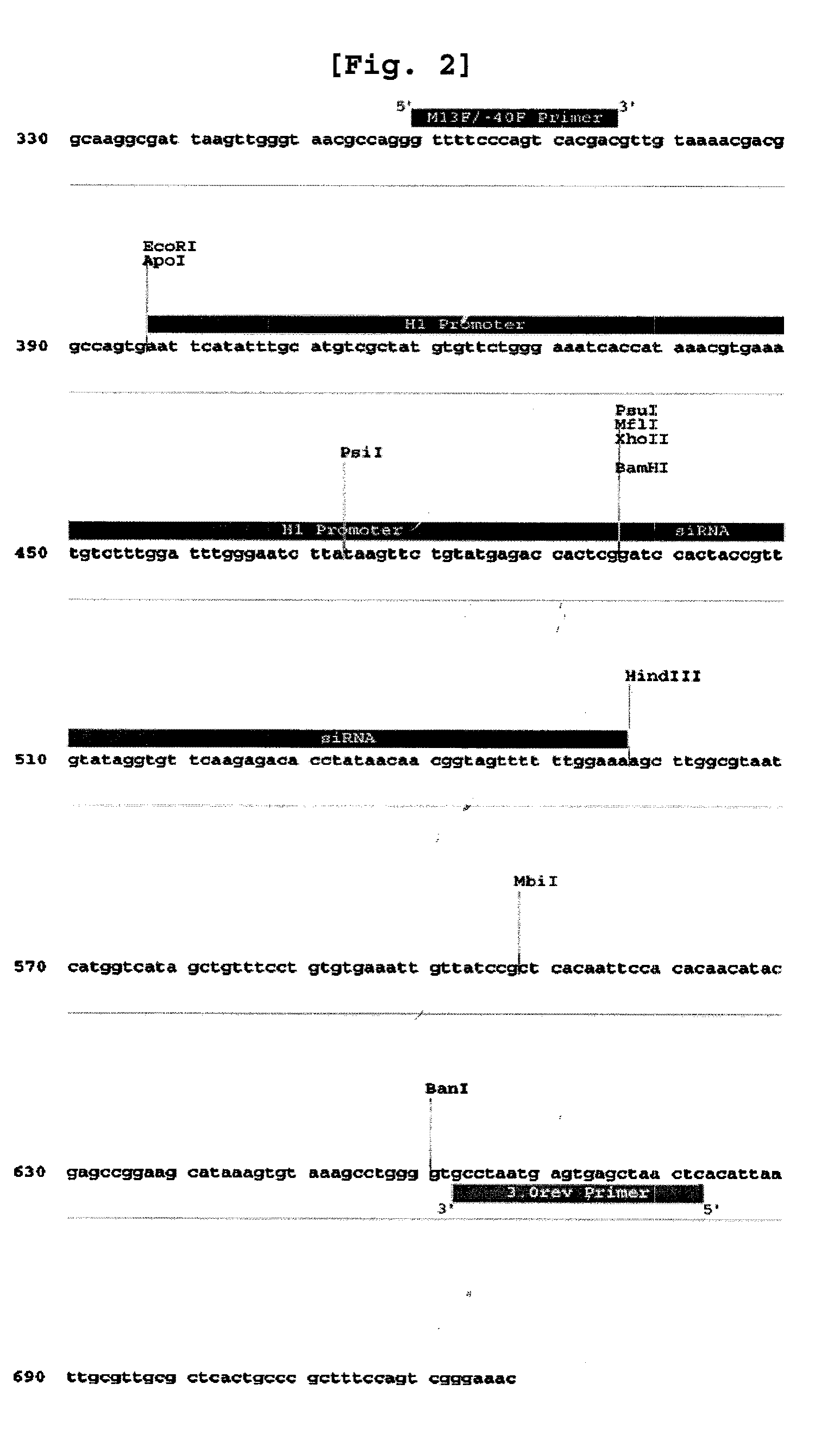Gene therapy for cancer using small interfering RNA specific to ant2 and a method to overcome tolerance to antitumor agent
a gene therapy and cancer technology, applied in the field of gene therapy for cancer using small interfering rna specific to ant2, can solve the problems of ratio therapy carrying serious side effects, not being able to treat spine and dispersed tumors, and not being able to overcome tumors. the effect of tumors is not good, and the effect of reducing the number of tumors
- Summary
- Abstract
- Description
- Claims
- Application Information
AI Technical Summary
Benefits of technology
Problems solved by technology
Method used
Image
Examples
example 1
Construction of ANT2 siRNA Expression Vector
[0059]ANT2 siRNA was provided by National Center for Biotechnology Information (NCBI, http: / / www.ncbi.nlm.nih.gov / ) and further prepared based on the nucleotide sequence corresponding to the second exon (SEQ. ID. NO: 2) of Genebank Accession No. NM—001152 (SEQ. ID. NO: 1), which is the nucleotide sequence of the most appropriate oligomer of all the candidate sequences obtained from the siRNA prediction program (http: / / www.ambion.com / technical, resources / siRNA target finder). The present inventors also constructed ANT2 siRNA-2 (SEQ. ID. NO: 14; 5′-CUGACAUCAUGUACACAGG-31) and ANT2 siRNA-3 (SEQ. ID. NO: 15; 5′-GAUUGCUCGUGAUGAAGGA-3′), in addition to ANT2 siRNA for comparison. The construction of ANT2 siRNA, ANT2 siRNA-2 and ANT2 siRNA-3 was conducted by Bionner (Korea).
[0060]Particularly, the vector was designed to include a sense sequence (5′-GCAGAUCACUGCAGAUAAG-3′, SEQ. ID. NO: 2) corresponding to 197-217 of ANT2 mRNA (SEQ. ID. NO: 1) that ...
example 2
Measurement of the Activity of ANT2 siRNA Expression Vector
[0061] Inhibitory Effect of ANT2 siRNA on ANT2 Expression
[0062]In this invention, ANT2 expressions in different human cancer cell lines were investigated. As a result, the present inventors selected a breast cancer cell line (MDA-MB-231) exhibiting high ANT2 expression for the experiment (FIG. 3A). The MDA-MB-231 cell line of the invention was purchased from Korean Cell Line Bank (KCLB) and cultured in DMEM (Sigma) supplemented with 10% FBS (fetal bovine serum), 100 units / ml of penicillin and 100 ug / ml of streptomycin (Sigma) in a 37° C., 5% CO2 incubator (Sanyo, Japan).
[0063]To investigate whether ANT2 siRNA of the invention could actually inhibit ANT2 expression, RT-PCR was performed with the said breast cancer cell line in the presence of ANT2 siRNA to measure the level of ANT2 expression. Particularly, the cells were distributed into a 6-well plate (2×105 cells) or 100 mm dish (2×106 cells), followed by culture for 24 ho...
example 3
Mechanism of Inducing Apoptosis by ANT2 siRNA
[0092]After observing the indirect apoptosis inducing effect of ANT2 siRNA, the present inventors tried to analyze the mechanism of inducing apoptosis. Particularly, the inventors investigated the expressions of TNF-α and one of its receptors TNF-α receptor 1(TNFR1) in the cancer cell line after ANT2 siRNA treatment. More specifically, ANT2 siRNA and scramble siRNA (control) were introduced into MDA-MB-231 cells, followed by culture for 24 hours. Then, the cells were treated with 10 μg / ml of BFA (brefeldin A: eBioscience, USA) for 6 hours to interrupt the extracellular secretion of TNF-α. Then, the levels of TNF-α and TNFR1 were measured by RT-PCR or FACS.
[0093]As a result, RT-PCR and FACS analysis confirmed that the levels of TNF-α and TNF-α receptor 1 (TNFR1) significantly increased by ANT2 siRNA in the cells. To confirm whether indirect apoptosis inducing effect was caused by TNF-α or not, the culture medium of cells transfected with A...
PUM
| Property | Measurement | Unit |
|---|---|---|
| Electrical resistance | aaaaa | aaaaa |
| Covalent bond | aaaaa | aaaaa |
Abstract
Description
Claims
Application Information
 Login to View More
Login to View More - R&D
- Intellectual Property
- Life Sciences
- Materials
- Tech Scout
- Unparalleled Data Quality
- Higher Quality Content
- 60% Fewer Hallucinations
Browse by: Latest US Patents, China's latest patents, Technical Efficacy Thesaurus, Application Domain, Technology Topic, Popular Technical Reports.
© 2025 PatSnap. All rights reserved.Legal|Privacy policy|Modern Slavery Act Transparency Statement|Sitemap|About US| Contact US: help@patsnap.com



